Dado un número, la tarea es verificar si este número es Palindrome o no usando Command Line Arguments .
Ejemplos:
Input: 123 Output: No Input: 585 Output: Yes
Acercarse:
- Dado que el número se ingresa como Argumento de línea de comando , no hay necesidad de una línea de entrada dedicada
- Extraiga el número de entrada del argumento de la línea de comando
- Este número extraído será de tipo String.
- Convierta este número en un tipo entero y guárdelo en una variable, digamos num
- Encuentre el reverso de este número y guárdelo en una variable, digamos rev_num
- Compruebe si este rev_num y num son iguales o no.
- Si no son iguales, el número no es palíndromo.
- Si son iguales, el número es un palíndromo.
Programa:
C
// C program to check if a number is Palindrome
// using command line arguments
#include <stdio.h>
#include <stdlib.h> /* atoi */
// Function to reverse the number
int reverseNumber(int num)
{
// Variable to store the
// resultant reverse number
int rev_num = 0;
// Traverse through the number digit by digit
while (num > 0) {
// Append the last digit of num
// as the next digit of rev_num
rev_num = rev_num * 10 + num % 10;
// Remove the last digit from the num
num = num / 10;
}
// Return the reversed number
return rev_num;
}
// Function to reverse a string
int isPalindrome(int num)
{
int rev_num = reverseNumber(num);
if (num == rev_num)
return 1;
else
return 0;
}
// Driver code
int main(int argc, char* argv[])
{
int num, res = 0;
// Check if the length of args array is 1
if (argc == 1)
printf("No command line arguments found.\n");
else {
// Get the command line argument and
// Convert it from string type to integer type
// using function "atoi( argument)"
num = atoi(argv[1]);
// Check if it is Palindrome
res = isPalindrome(num);
// Check if res is 0 or 1
if (res == 0)
// Print No
printf("No\n");
else
// Print Yes
printf("Yes\n");
}
return 0;
}
Java
// Java program to check if a number is Palindrome
// using command line arguments
class GFG {
// Function to reverse the number
public static int reverseNumber(int num)
{
// Variable to store the
// resultant reverse number
int rev_num = 0;
// Traverse through the number digit by digit
while (num > 0) {
// Append the last digit of num
// as the next digit of rev_num
rev_num = rev_num * 10 + num % 10;
// Remove the last digit from the num
num = num / 10;
}
// Return the reversed number
return rev_num;
}
// Function to reverse a string
public static int isPalindrome(int num)
{
int rev_num = reverseNumber(num);
if (num == rev_num)
return 1;
else
return 0;
}
// Driver code
public static void main(String[] args)
{
// Check if length of args array is
// greater than 0
if (args.length > 0) {
// Get the command line argument and
// Convert it from string type to integer type
int num = Integer.parseInt(args[0]);
// Get the command line argument
// and check if it is Palindrome
int res = isPalindrome(num);
// Check if res is 0 or 1
if (res == 0)
// Print No
System.out.println("No\n");
else
// Print Yes
System.out.println("Yes\n");
}
else
System.out.println("No command line "
+ "arguments found.");
}
}
Producción:
Publicación traducida automáticamente
Artículo escrito por RishabhPrabhu y traducido por Barcelona Geeks. The original can be accessed here. Licence: CCBY-SA

